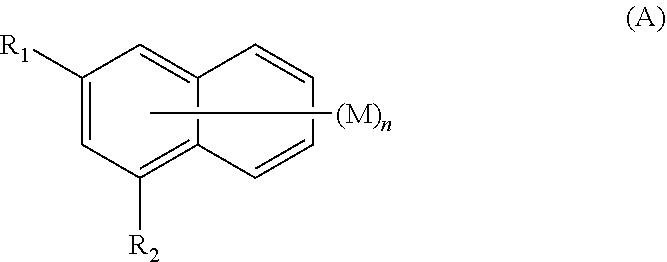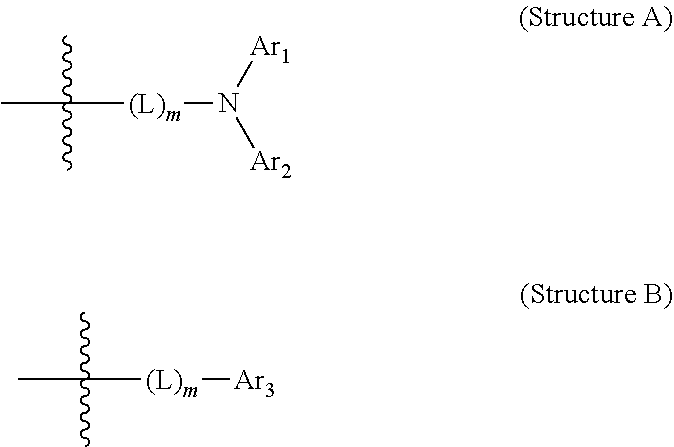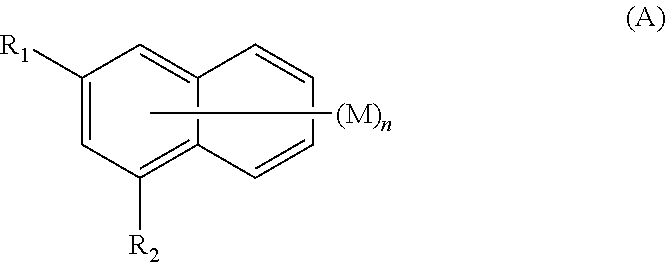Amine-substituted naphthalene derivatives and organic light emitting diodes including the same
- Summary
- Abstract
- Description
- Claims
- Application Information
AI Technical Summary
Benefits of technology
Problems solved by technology
Method used
Image
Examples
synthesis example 1
Synthesis of Compound 1
[0066](1) Synthesis Example 1-(1): Synthesis of Intermediate 1-a
[0067]335 g (1.5 mol) of 3-bromo-1-naphthol, 246 g (2.0 mol) of phenylboronic acid, 33.5 g (31.0 mmol) of tetrakis(triphenylphosphine)palladium, 430 g (3.1 mol) of potassium carbonate, 2 L of toluene, 2 L of 1,4-dioxane, and 1 L of water were refluxed in a round-bottom flask for 16 h. After completion of the reaction, the reaction mixture was left standing for layer separation. The organic layer was concentrated under reduced pressure and recrystallized from toluene and methanol to afford 330 g of Intermediate 1-a (yield 75%).
[0068](2) Synthesis Example 1-(2): Synthesis of Intermediate 1-b
[0069]20 g (0.091 mol) of Intermediate 1-a was placed in a round-bottom flask and 200 mL of dichloromethane was added thereto. The mixture was stirred. The mixture was added with 10.8 g (0.136 mol) of pyridine and was cooled to 0° C. After slow dropwise addition of 38.4 g (0.136 mol) of trifluoromethanesulfonic a...
synthesis example 2
Synthesis of Compound 7
[0073](1) Synthesis Example 2-(1): Synthesis of Intermediate 2-a
[0074]20 g (0.057 mol) of Intermediate 1-b, 21.6 g (0.085 mol) of bis(pinacolato)diborane, 1.2 g (0.002 mol) of [1,1′-bis(diphenylphosphino)ferrocene]palladium(II) dichloride, 16.7 g (0.17 mol) of potassium acetate, and 200 mL of toluene were added to a round-bottom flask under a nitrogen atmosphere. The mixture was refluxed. After completion of the reaction, the reaction mixture was left standing for layer separation. The organic layer was concentrated under reduced pressure, purified by column chromatography, and dried to afford 15 g of Intermediate 2-a (yield 80%)
[0075](2) Synthesis Example 2-(2): Synthesis of Intermediate 2-b
[0076]Intermediate 2-b was synthesized in the same manner as in Synthesis Example 1-(1), except that 1,4-bromoiodobenzene and Intermediate 2-a were used instead of 3-bromo-1-naphthol and phenylboronic acid, respectively.
[0077](3) Synthesis Example 2-(3): Synthesis of Compo...
synthesis example 3
Synthesis of Compound 14
[0080](1) Synthesis Example 3-(1): Synthesis of Intermediate 3-a
[0081]Intermediate 3-a was synthesized in the same manner as in Synthesis Example 1-(3), except that 4-aminobiphenyl was used instead of bis(biphenyl-4-yl)amine.
[0082](2) Synthesis Example 3-(2): Synthesis of Compound 14
[0083]Compound 14 was synthesized in the same manner as in Synthesis Example 2-(3), except that Intermediate 3-1 and 2-bromodibenzothiophene were used instead of Intermediate 2-b and bis(biphenyl-4-yl)amine, respectively.
[0084]MS (MALDI-TOF): m / z 533.19[M+]
PUM
 Login to View More
Login to View More Abstract
Description
Claims
Application Information
 Login to View More
Login to View More - Generate Ideas
- Intellectual Property
- Life Sciences
- Materials
- Tech Scout
- Unparalleled Data Quality
- Higher Quality Content
- 60% Fewer Hallucinations
Browse by: Latest US Patents, China's latest patents, Technical Efficacy Thesaurus, Application Domain, Technology Topic, Popular Technical Reports.
© 2025 PatSnap. All rights reserved.Legal|Privacy policy|Modern Slavery Act Transparency Statement|Sitemap|About US| Contact US: help@patsnap.com



